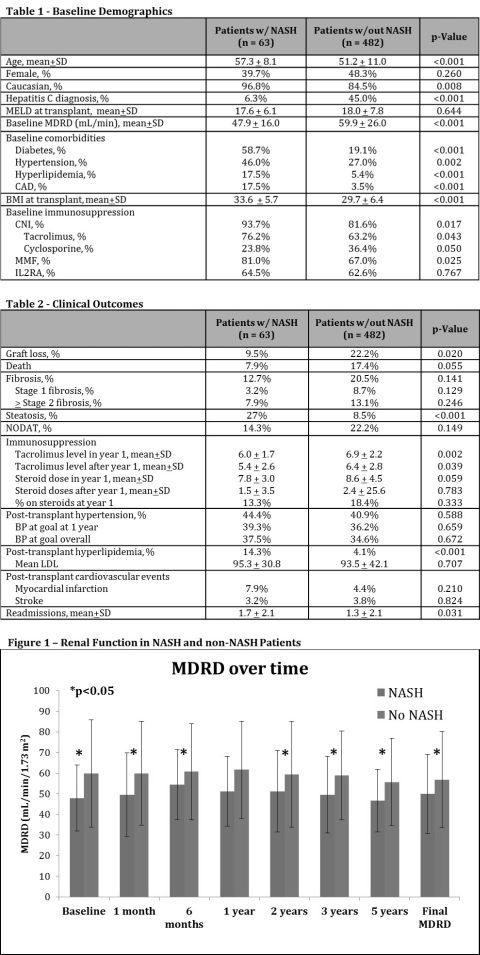Liver Transplant for NASH: We Need To Spare the Nephron!
Pharmacy, MUSC, Charleston, SC
Transplant, MUSC, Charleston, SC
Meeting: 2013 American Transplant Congress
Abstract number: 141
Background: The aim of this study was to evaluate outcomes of patients transplanted for NASH cirrhosis compared to those without NASH.
Methods: Single center retrospective longitudinal cohort study of 704 liver patients transplanted at an academic medical center from 2000-2011. Exclusions were pediatrics (n=47), incomplete records (n=45), and those who died within 30 days of transplant (n=67). Steatosis recurrence was defined as any steatosis reported on biopsy, NODAT was defined as insulin or oral antihyperglycemic requirement >30 days after transplant, and MDRD was calculated using the abbreviated equation.
Results: 545 patients were included (63 with NASH and 482 without). Baseline demographics (Table 1) demonstrate that NASH patients were older, Caucasian, and obese with expectedly higher rates of DM, hyperlipidemia, HTN and CAD. Baseline renal function was also significantly lower in the NASH patients. Table 2 displays transplant characteristics and outcomes. Graft loss was significantly higher in the non-NASH group (9.5% vs 22.2%, p=0.020), and death trended towards significance in the non-NASH group as well (7.9% vs 17.4%, p=0.055). Cardiovascular outcomes, including stroke and MI, were not significantly different between the groups. Steatosis was higher in the NASH group (27% vs 9%, p<0.001), and 9% of non-NASH patients experienced de novo steatosis after transplant. Additionally, tacrolimus levels and steroid doses were lower in the NASH group. Table 3 and Figure 1 show MDRD for both groups at baseline and follow-up. NASH patients continued to have inferior renal function throughout the study period (mean MDRD 50 vs 57 mL/min, p=0.025).
Conclusion: Despite multiple pre-transplant risk factors for CVD, the NASH liver transplant recipients had as good or better overall outcomes. However, the poor baseline renal function continues to decline suggesting that in the long term, renal sparing regimens are critical in this group.

To cite this abstract in AMA style:
Jordan C, Pilch N, Taber D, Meadows H, Fleming J, Mardis A, Morbitzer K, Makowski C, McGillicuddy J, Bratton C, Lin A, Baliga P, Chavin K. Liver Transplant for NASH: We Need To Spare the Nephron! [abstract]. Am J Transplant. 2013; 13 (suppl 5). https://atcmeetingabstracts.com/abstract/liver-transplant-for-nash-we-need-to-spare-the-nephron/. Accessed December 28, 2025.« Back to 2013 American Transplant Congress
